Complete Espresso Machine Guide 2025
The Complete Commercial Espresso Machine Guide 2025
From $450 Workhorses to $12,000 Italian Masterpieces: Your Data-Driven Auction Buying Guide
The $450 Reality: What Espresso Machines Actually Cost at Auction
Walk into any commercial equipment auction and you'll see espresso machines ranging from $51 to $12,250. The median price? $450. But that number hides the real story.
After analyzing 173 espresso machine sales, here's what actually determines auction value: group count, brand prestige, and whether someone in the room recognizes what they're bidding on. A dusty La Marzocco that looks like it's been through a war can sell for $6,300 because a single bidder knows it's a $16,000+ machine new. Meanwhile, a perfectly functional 2-group workhorse sits at $525 because nobody's fighting over it.
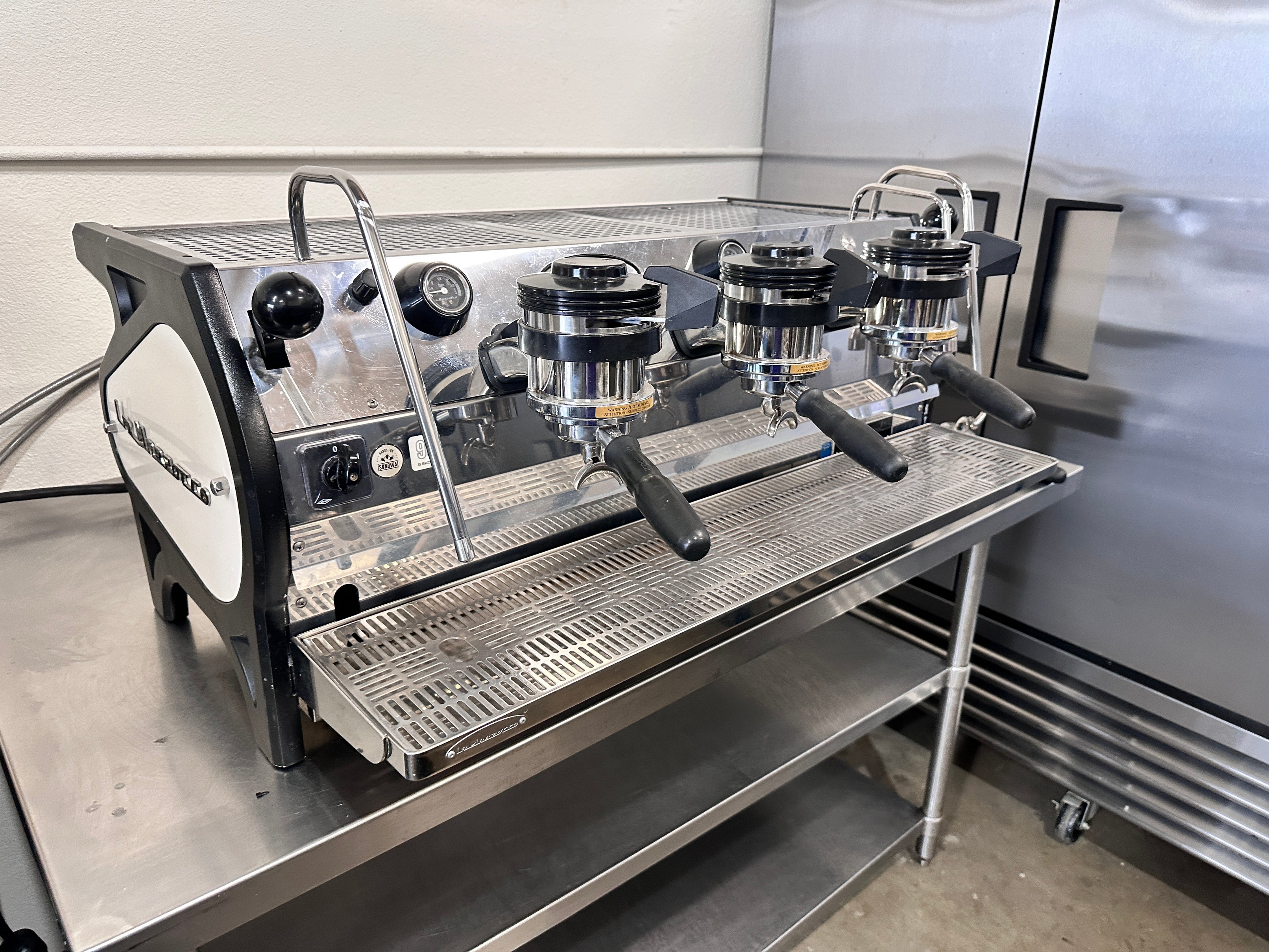
This La Marzocco 3-group machine isn't just equipment—it's a statement piece worth bidding on
The Price Breakdown:
52% of machines sell under $500 • 32% fall between $500-$1,500 • 6% reach $1,500-$3,000 • Only 9% exceed $3,000
Translation: Most buyers are getting functional machines at budget prices, while a small group is investing in premium Italian equipment at 30-50% of retail.
Why Espresso Machines Are Different: The Forward-Facing Investment
Here's something most equipment guides won't tell you: espresso machines aren't just kitchen equipment. They're marketing tools.
A commercial fryer lives in the back of house, judged purely on output capacity and reliability. An espresso machine sits front and center, telling customers "we take coffee seriously" before they've even ordered. That gleaming chrome Italian machine isn't art, but it's a symphony of engineering, aesthetics, and performance—like a Ferrari serving the practical purpose of transportation while making a statement about quality.
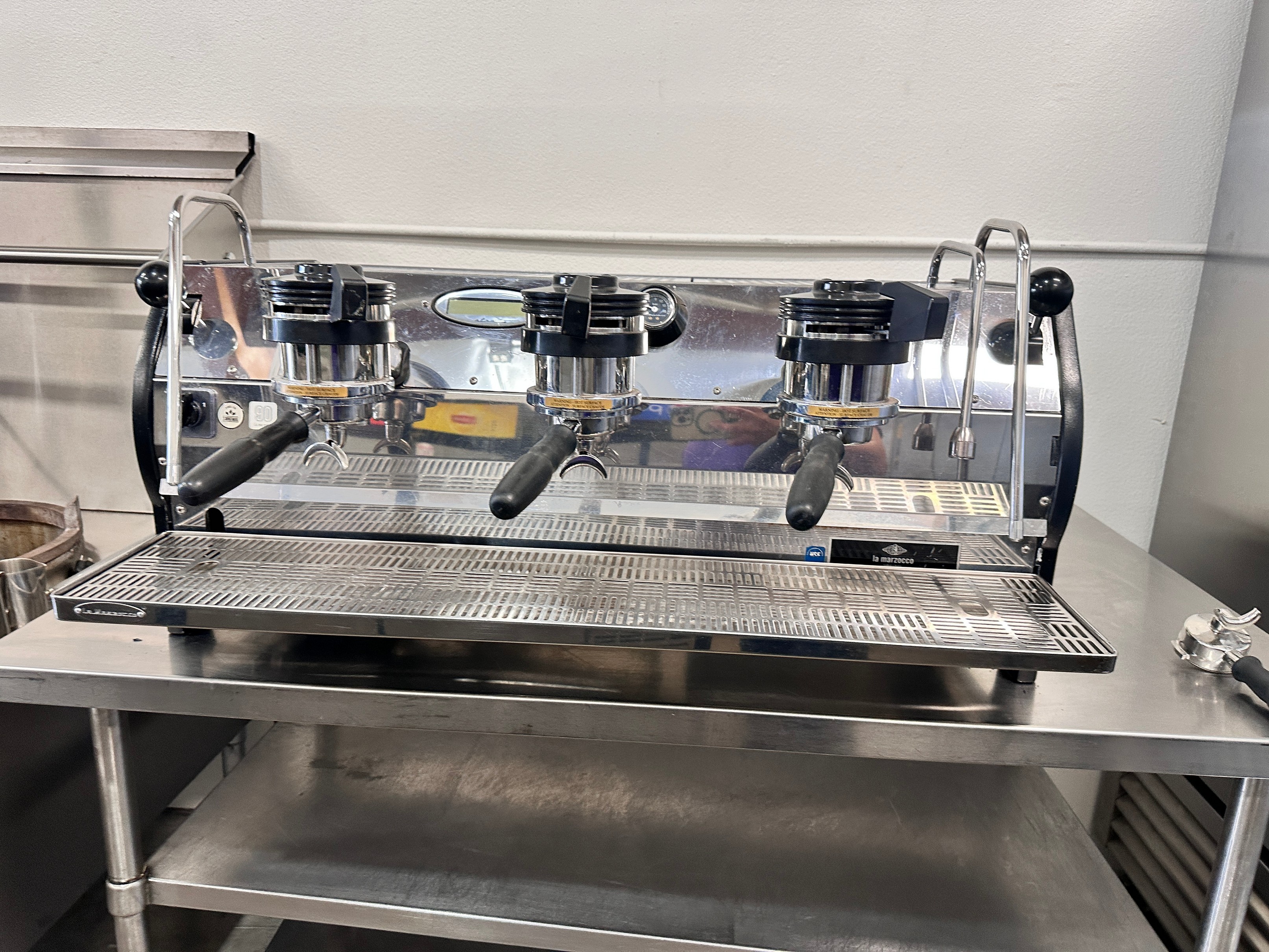
The Ferrari of espresso machines: La Marzocco 3-group commanding premium bids
This forward-facing reality affects everything: what you buy, what you bid, and whether that premium Italian brand is worth 4x the price of a mid-tier workhorse. When customers can see your equipment, perception becomes part of the value proposition.
Auction Insider Tip: Location matters for pricing strategy. Open kitchen or counter service? Budget for the visual premium—buyers compete harder for pretty machines. Back of house installation? Focus purely on functionality and save thousands.
Semi-Automatic vs Superautomatic: The Art vs Automation Decision
The espresso world splits into two camps, and the divide runs deeper than just mechanics—it's philosophy.
Semi-Automatic Machines: The Barista's Canvas
These are what you picture: portafilter locks, manual tamp pressure, steam wand technique. The operator controls grind, dose, tamp, extraction time, and milk texture. Many in the industry call brewing an art (though it can't technically be art since it serves a practical purpose). For those folks, semi-automatic machines provide the paintbrush. Remove that control and you've taken away the craft.
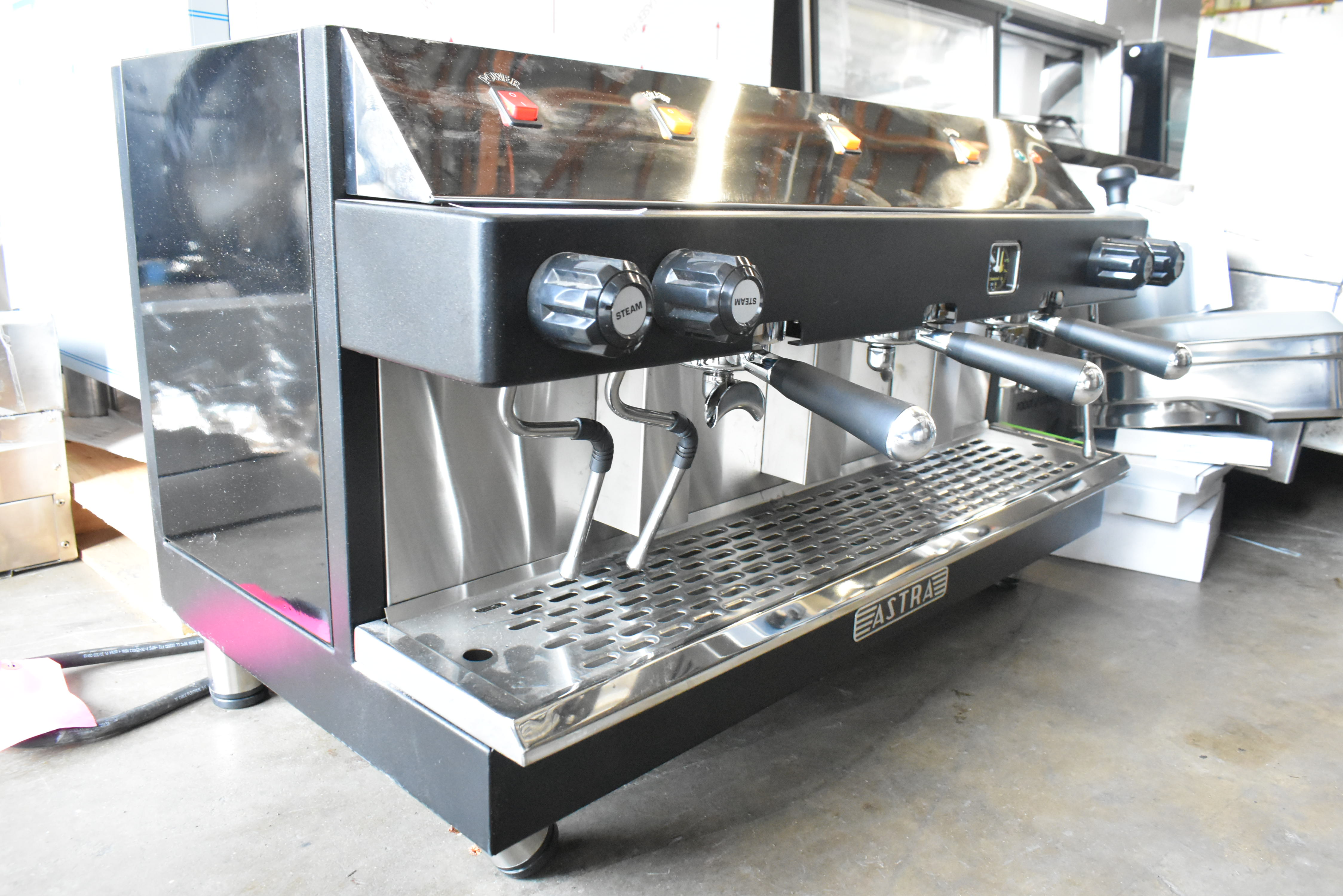
Classic semi-automatic controls: full barista control over every variable
Auction Reality: Semi-automatic machines from premium Italian brands command bidding wars. That's where the $3,000-$12,000 sales live. Mid-tier semi-autos (Nuova Simonelli, Rancilio) typically run $500-$2,000 depending on group count and condition.
Superautomatic Machines: The Efficiency Play
Push a button. Walk away with consistent espresso. Integrated grinders, automatic tamping, programmable recipes, minimal training required. For hotels, corporate cafeterias, high-volume operations where consistency matters more than craft, these are practical workhorses.
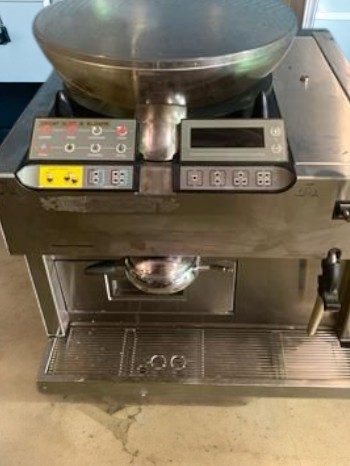
Mastrena superautomatic with integrated grinder: push-button consistency for high volume
Auction Reality: Superautomatics sell for LESS at auction precisely because serious coffee shops don't want them. You're looking at $450-$1,500 for most units. The flip side? For the right application (diner breakfast service, hotel lobby), that's a feature not a bug. Lower acquisition cost, easier staffing, consistent output.
Semi-Automatic
Best For: Specialty cafes, artisan bakeries, fine dining, any operation where coffee quality is a differentiator
Auction Range: $500-$12,000
Training: Extensive barista training required
Superautomatic
Best For: Hotels, diners, corporate cafeterias, high-volume convenience operations
Auction Range: $450-$1,500
Training: Minimal—button operation
The Training Consideration: Semi-automatic machines require skilled baristas. Factor in training time and labor costs. If you can't maintain barista quality standards, superautomatic consistency might deliver better customer experience than poorly-pulled shots from an expensive Italian machine.
Group Count Economics: Sizing Your Machine to Your Operation
Group heads—the business end where portafilters lock in—directly correlate with throughput capacity and auction pricing. But it's not a simple linear scale. A 1-group Nuova Simonelli can sell for more than a 2-group off-brand simply due to quality and longevity.
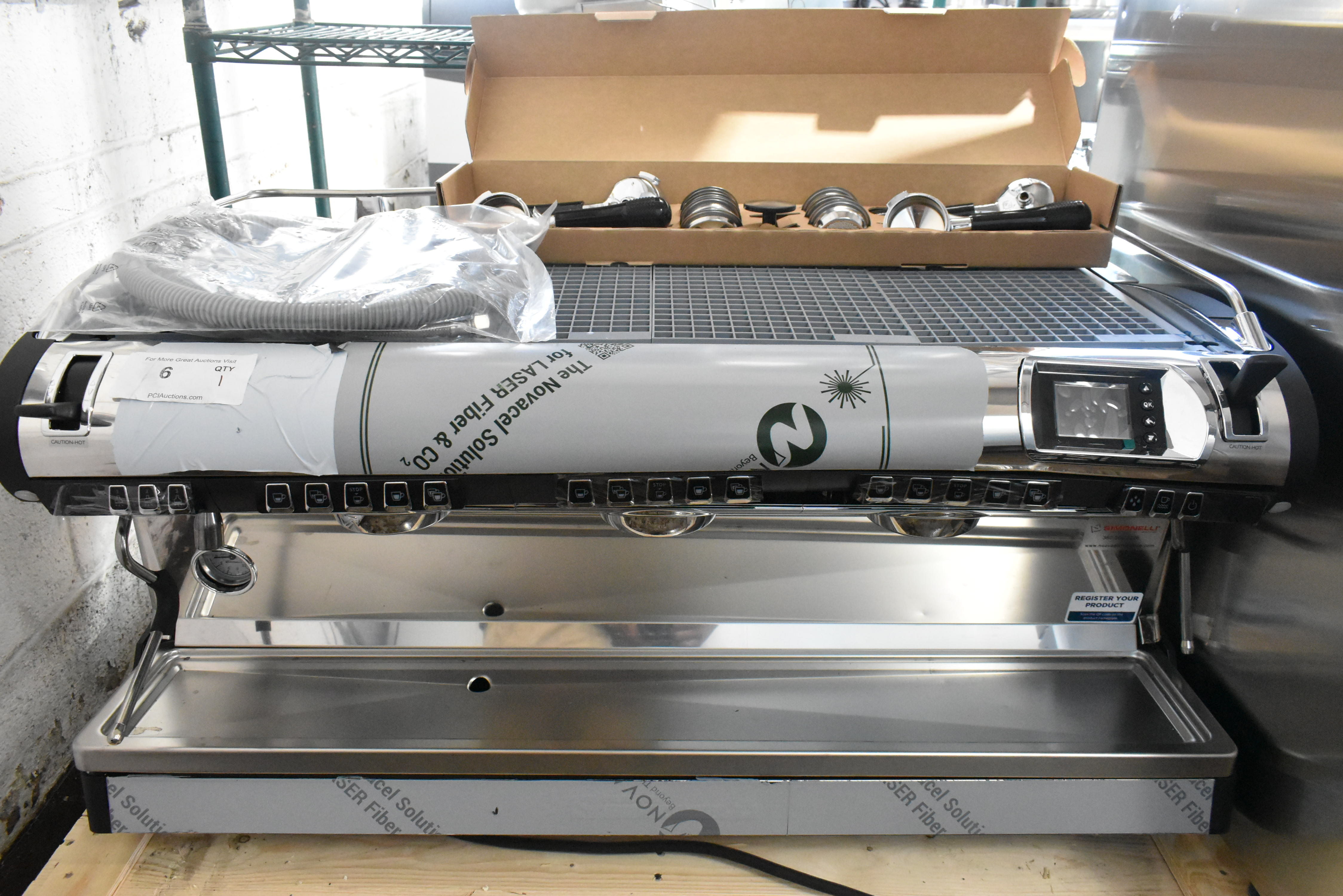
3-group machine with complete portafilters and baskets—commanding premium at auction
| Group Count | Typical Auction Range | Best Applications | Cups Per Hour |
|---|---|---|---|
| 1-Group | Up to $1,200 | Home/prosumer, small cafe, food truck, bakery with light coffee service | 20-30 |
| 2-Group | $500-$4,000 | Standard cafe, restaurant bar, bistro, breakfast-focused diner | 40-60 |
| 3-Group | $1,000-$12,000 | High-volume cafe, specialty coffee shop, hotel restaurant, event catering | 60-90 |
| 4-Group | $2,500+ (rare) | Extreme high-volume operations, convention centers, airport terminals | 90+ |
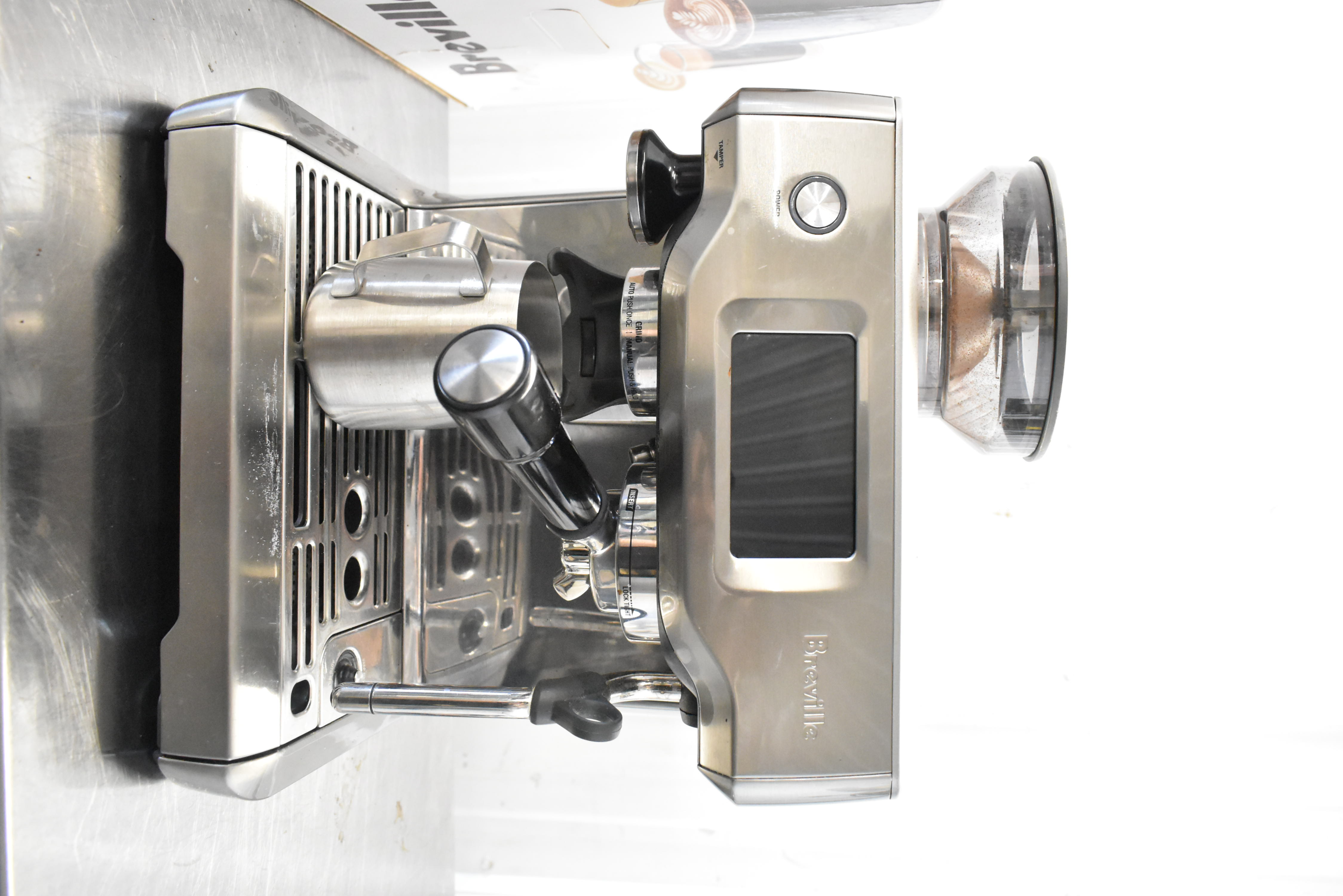
Single-group Breville sold for $355—perfect example of budget entry point for small operations
The Volume Reality Check: A 2-group machine can theoretically produce 40-60 cups per hour, but that's working the machine continuously. Real-world cafe service with order spacing, milk steaming, cleanup? You're looking at 20-30 drinks per hour even with two groups. Size for your peak hours, not theoretical maximums.
Auction Insider Tip: 4-group machines almost never appear at auction. When they do, they're over $2,500 minimum. If you truly need that capacity, you're likely better off with two 2-group machines for redundancy and flexibility—and they'll be easier to find at auction.
Brand Hierarchy: When Italian Premium Actually Pays Off
The espresso machine market has a clear prestige ladder, and auction pricing reflects it ruthlessly.
Italian Premium Tier: The La Marzocco Effect
La Marzocco represents the peak. These machines command 2-4x the price of "good enough" alternatives at auction. Recent sales data: $3,000, $3,246, $3,350, $3,602, $3,999, $4,250, $4,500, $4,700, $4,752, $5,180, $6,300, and one remarkable $12,250 sale.
New retail? A La Marzocco Linea Mini starts at $6,000. A full commercial 3-group system runs $16,000-$35,000. So auction buyers are getting 30-50% of retail, sometimes better if nobody else recognizes the brand.
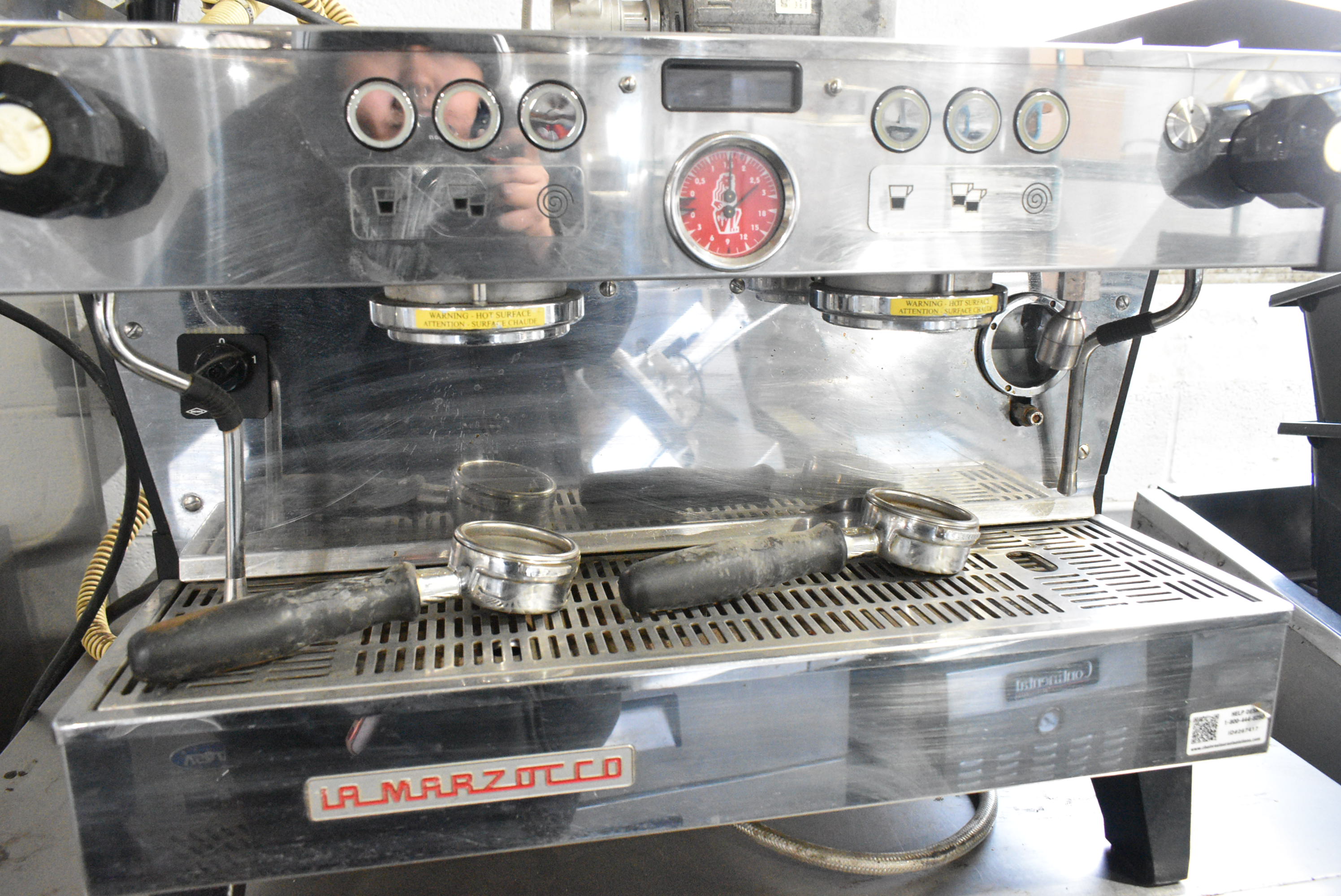
This dusty La Marzocco sold for $6,300 because one bidder recognized quality under the grime
Why the premium? It's not just performance. Most customers can't taste the difference between a perfect La Marzocco shot and a well-dialed mid-tier shot. You're buying engineering excellence, build quality that lasts 15+ years, and that forward-facing prestige we discussed. When a customer sees a La Marzocco, they know you invested in quality.
Mid-Tier Workhorses: The Smart Money Segment
Nuova Simonelli, Rancilio, La Spaziale—these are the Camry equivalent. Reliable, serviceable, respected brands that signal "we take coffee seriously" without the Ferrari price tag. Auction range typically $500-$2,500 depending on group count and condition.
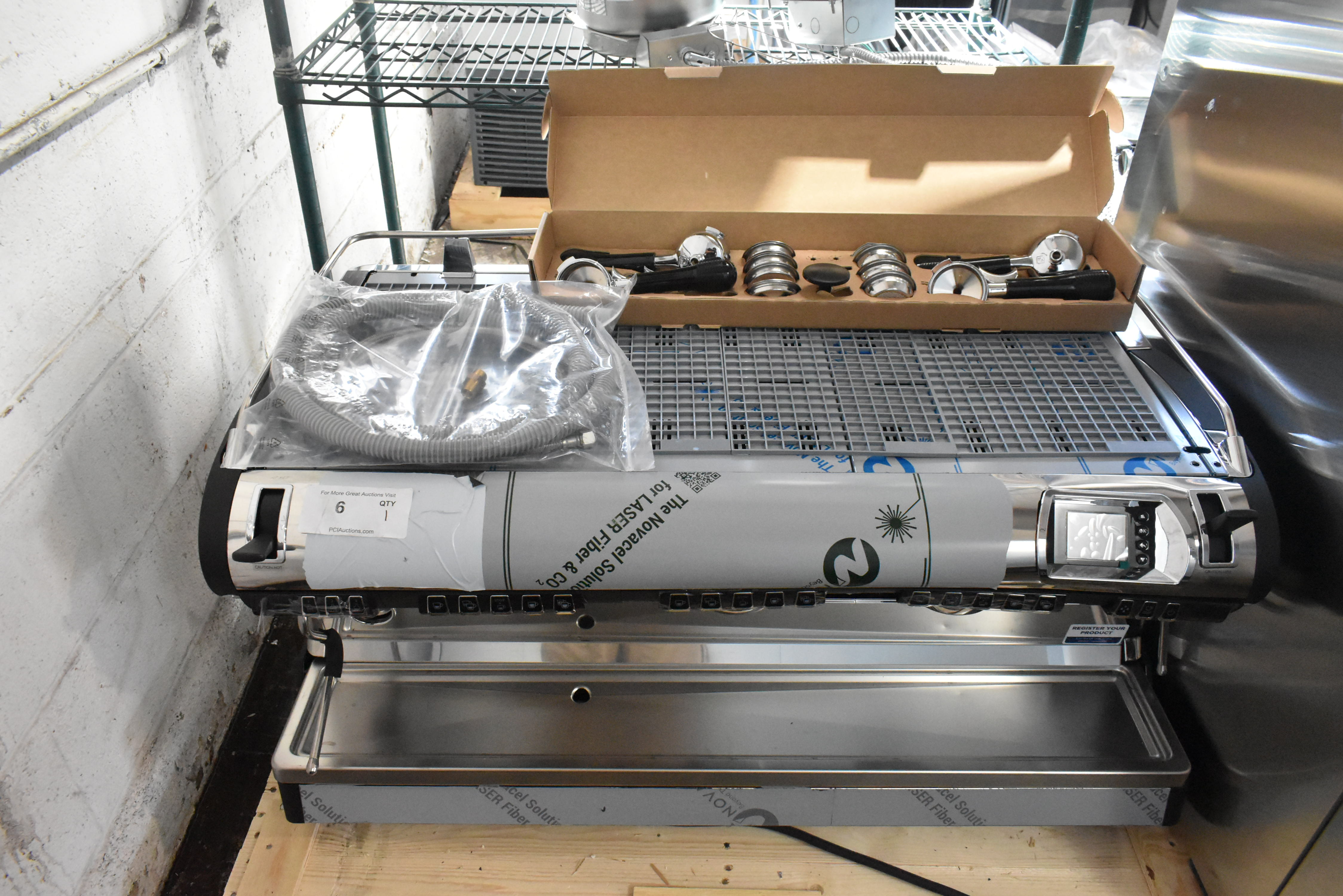
Brand new scratch & dent Nuova Simonelli—premium Italian quality at auction discount
These machines deliver professional results, parts availability is reasonable, and they don't scream "budget operation." For most cafes and restaurants, this is the sweet spot—good enough performance without the prestige premium.
Budget/Unknown Brands: Functional But Not Prestigious
Import brands, obscure manufacturers, consumer brands in commercial settings—these typically sell under $500 at auction. They'll make espresso, but finding replacement parts can be challenging, and they don't carry visual credibility.
The Risk Factor: Unknown brands may have proprietary parts that take weeks to source from overseas, or worse, may be discontinued with zero parts availability. That $200 machine becomes a parts unit the moment a gasket fails.
Brand New Scratch & Dent Alert: PCI Auctions regularly handles BNSD (brand new scratch & dent) units from premium manufacturers. These are full-quality machines with cosmetic issues—minor dents, scratches, wrong color orders. At auction, they can sell for 40-60% of retail. Watch for these opportunities if you can live with imperfect aesthetics.
Auction Insider Tip: Italian-made machines (or machines with Italian-sounding names) command premiums, but verify authenticity. Some manufacturers use European-sounding brand names despite being manufactured elsewhere. Check the spec plate for "Made in Italy" verification.
Power & Installation: The 208/240V Standard
Unlike some commercial equipment that offers 115V options, espresso machines are almost universally 208/240V single-phase power. This is non-negotiable for proper boiler and pump operation.
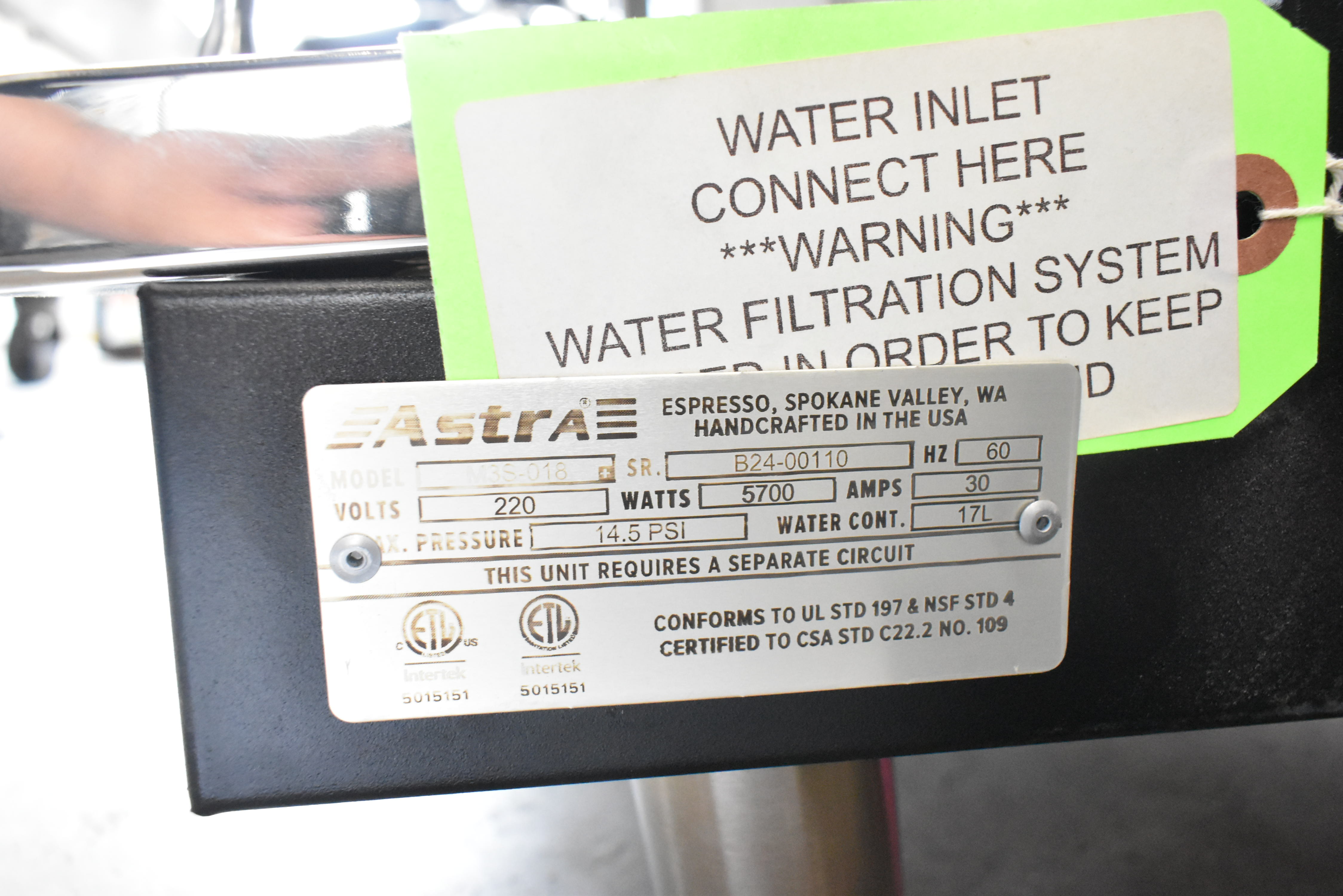
Spec plate showing 220V requirement—verify power availability before bidding
What This Means for Buyers
If you're opening or operating a coffee-focused establishment, you already have 208/240V service—it's standard commercial infrastructure. Any location with a commercial kitchen will have this available. It's simply the cost of doing business, not a supplementary addition.
Don't have 240V power? Running new service is part of your buildout, not an equipment problem. Budget $500-$2,000 for an electrician to run a dedicated 240V circuit depending on distance from your panel and local labor rates.
Water Line Connection: Autofill vs Manual
Commercial espresso machines require water supply. You have two options:
Direct plumb (recommended): Machine connects directly to water line with autofill. Boiler maintains water level automatically. This is the only viable option for any serious volume operation. Budget $200-$500 for plumbing connection during installation.
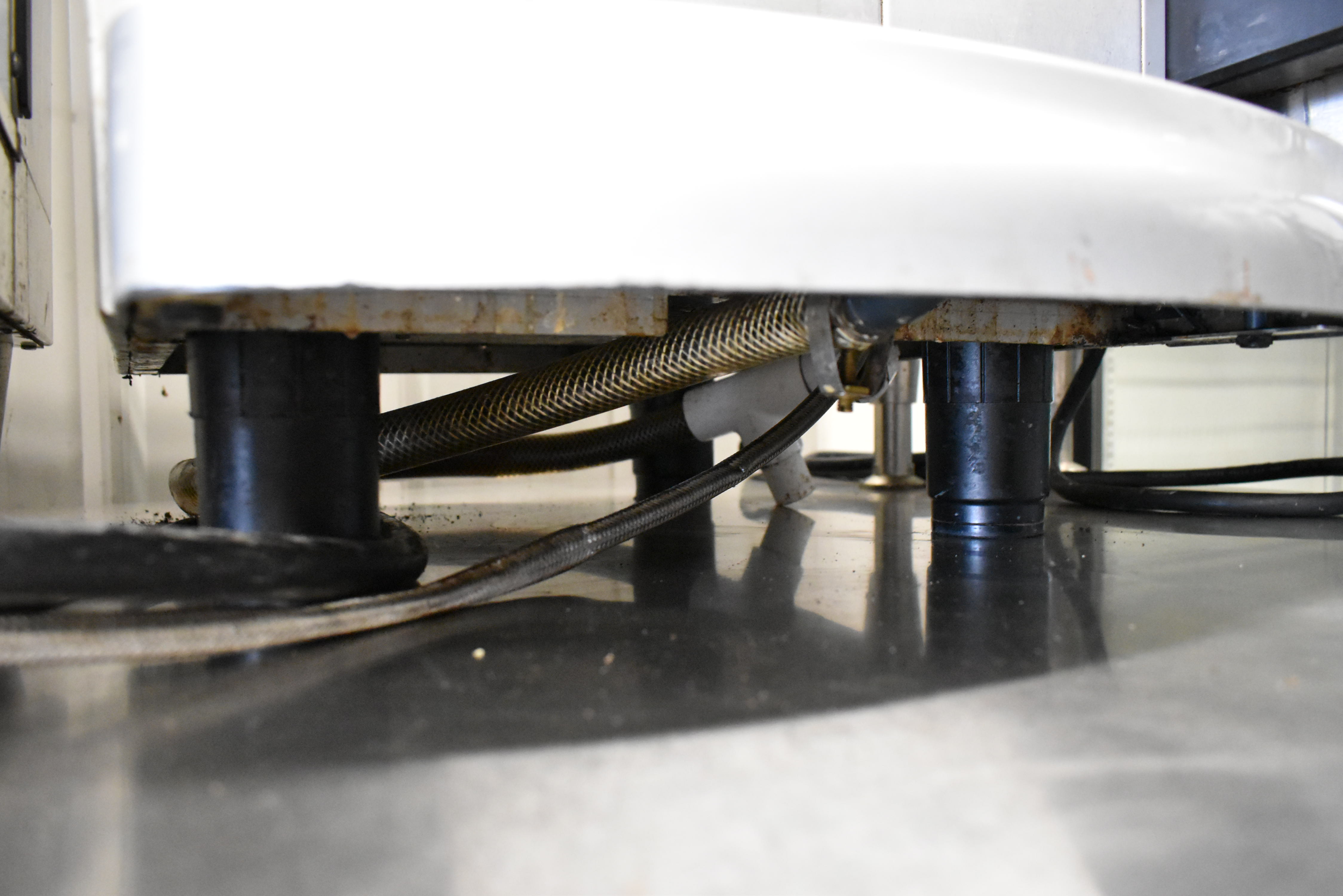
Water line hookup—essential for commercial volume operations
Manual fill (not recommended): Some smaller machines have internal reservoirs you refill by hand. This works for home use or very light commercial applications (food truck with 10 drinks per day), but it's inefficient and impractical for real volume.
3-Phase Power Myth: You may hear that large espresso machines require 3-phase power. This is false. Commercial espresso machines are universally single-phase 208/240V. If someone tells you otherwise, they're confusing espresso machines with walk-in coolers or other heavy equipment.
Auction Insider Tip: Voltage isn't negotiable, but it shouldn't affect auction pricing significantly. Buyers without 240V power simply don't bid on espresso machines—they're not driving prices down, they're removing themselves from the market entirely.
The Scale Problem: Hard Water's $1,000 Mistake
If there's one thing that destroys espresso machines faster than anything else, it's hard water. Scale buildup affects flavor (#1 concern for quality), damages boiler operation (#2 concern for longevity), and reduces water flow capacity (#3 concern for performance).
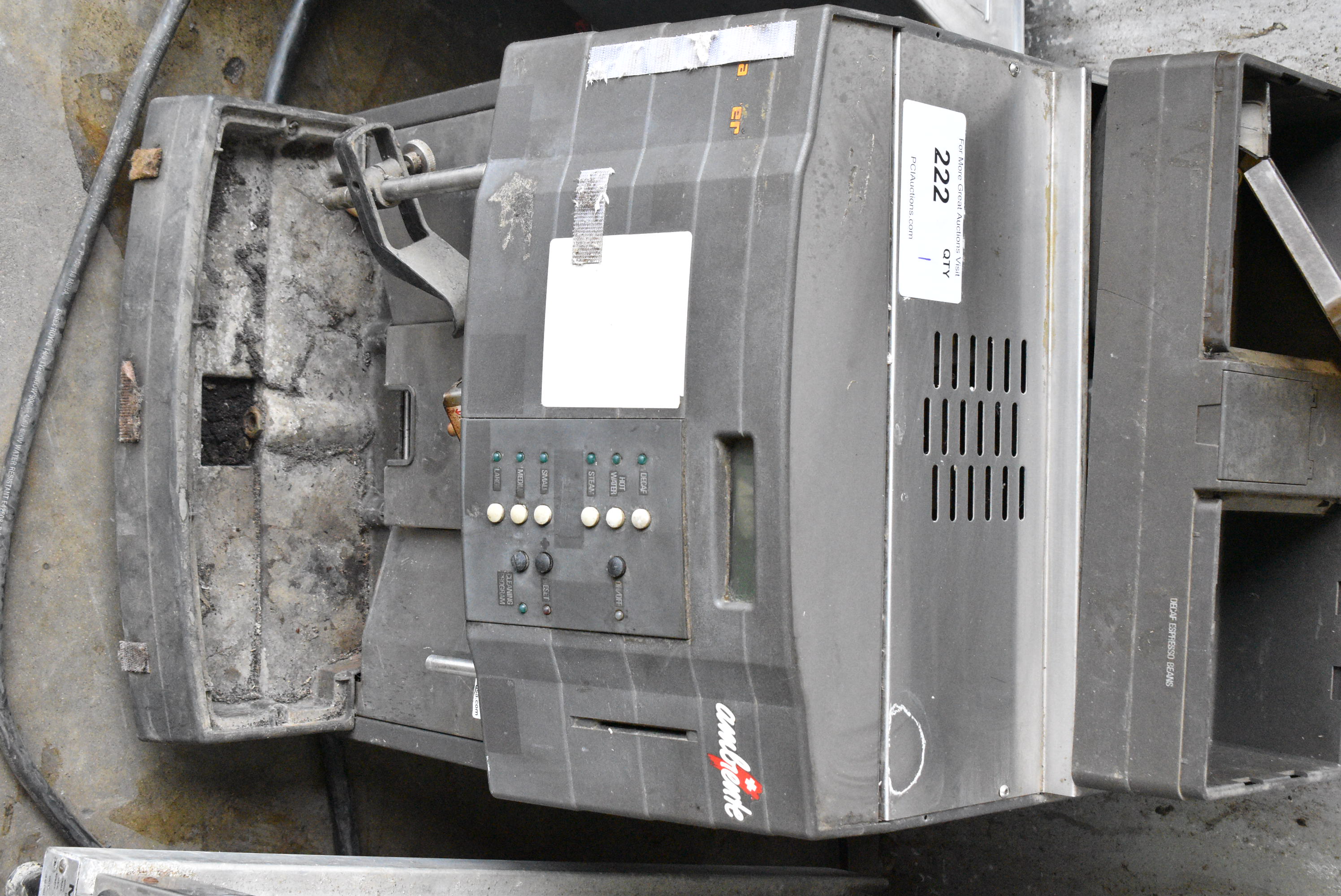
Scale buildup in drip tray—visible warning sign of internal scaling issues
Scale Detection at Auction Inspection
You can't open up the boiler during pre-auction inspection, but you can look for warning signs:
Drip tray scale: White mineral deposits in the drip tray indicate hard water has been running through the system. This doesn't mean the machine is damaged, but it does mean you should factor in professional descaling service ($200-$400) after purchase.
Water inlet inspection: Check the main water supply line or valve before bidding. Visible scale buildup at the connection point suggests internal scaling. On premium Italian machines, this is fixable but requires manufacturer-specific descaling protocols.
Boiler access ports: Some machines have inspection ports or removable panels that let you peek at the boiler exterior. Heavy external scaling = internal scaling.
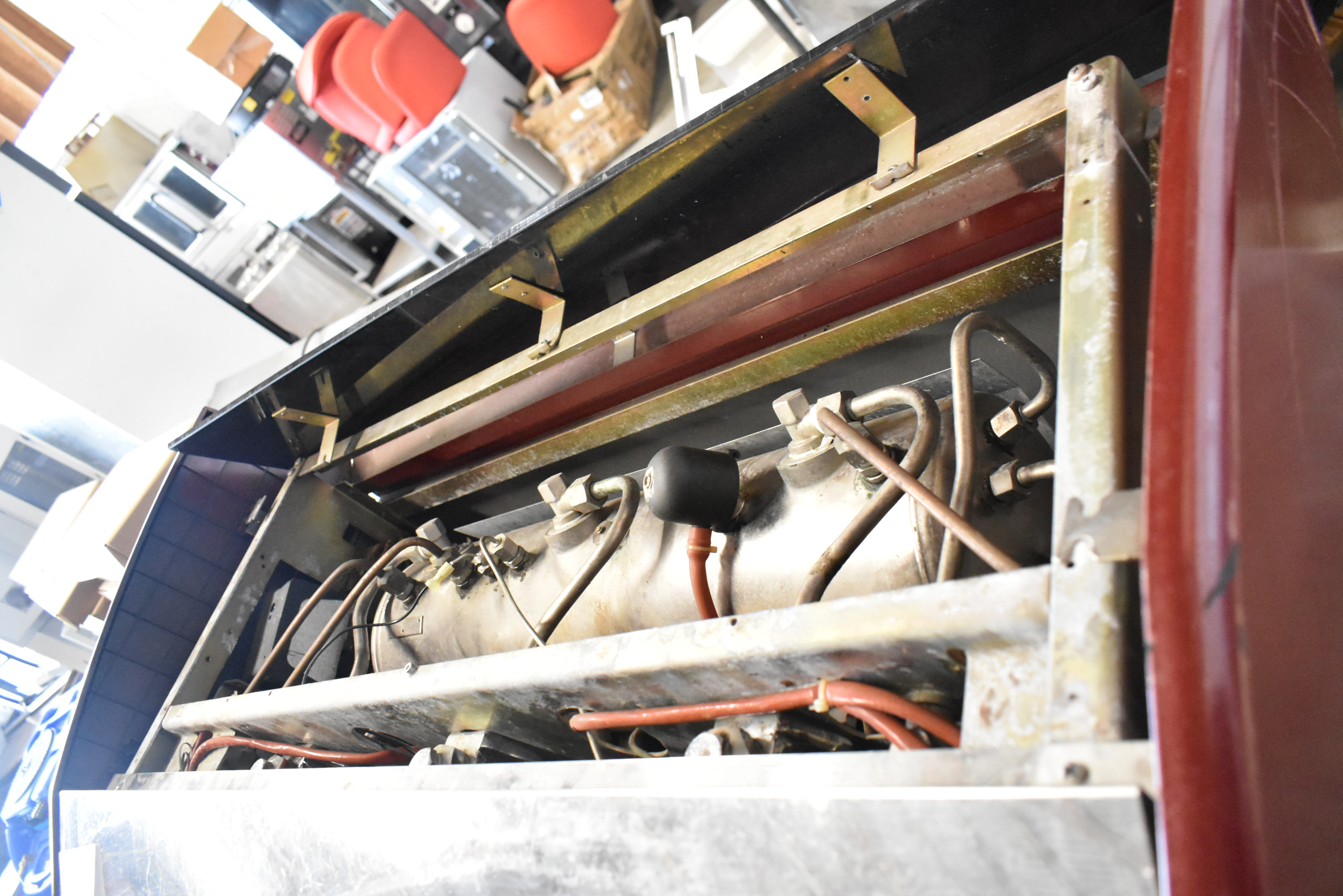
Internal boiler view (top panel removed)—rarely accessible during inspection, but shows what scaling affects
Prevention: Soft Water Is Non-Negotiable
Install a water softener or filtration system BEFORE you ruin a $3,000 machine. Options:
Whole-facility water softener (best): Benefits all equipment—espresso machines, ice machines, steamers, dishwashers. If you're building out a location, this should be part of your infrastructure plan.
Point-of-use filtration (minimum): Install a dedicated water filter immediately before the espresso machine. Budget $150-$400 for equipment plus filter replacements every 6 months ($50-$100).
The Water Quality Equation: Like ice machines, espresso output quality is directly tied to input water quality. You can have a $10,000 La Marzocco, but if you're running hard water through it, you're serving mineral-flavored coffee and cutting the machine's lifespan in half.
Descaling Schedule for Hard Water Areas
If you're stuck with hard water and can't install softening:
Monthly descaling with manufacturer-approved chemicals. This is time-consuming (2-4 hours including flush cycles) and requires taking the machine offline. Consult manufacturer service manuals for specific protocols—Italian machines especially have precise requirements that, if ignored, can void any remaining warranty or damage gaskets.
The False Economy of Skipping Water Treatment: A $300 water softener vs. a $1,000 boiler replacement. A $50 filter cartridge vs. $400 descaling service. Soft water isn't optional—it's the difference between 10+ years of service and 2 years before catastrophic failure.
Missing Parts Economics: The Portafilter Problem
Espresso machines live or die by their portafilters and baskets. These are the handled filters that lock into group heads and hold your coffee grounds. Lose them and you've got an expensive paperweight.
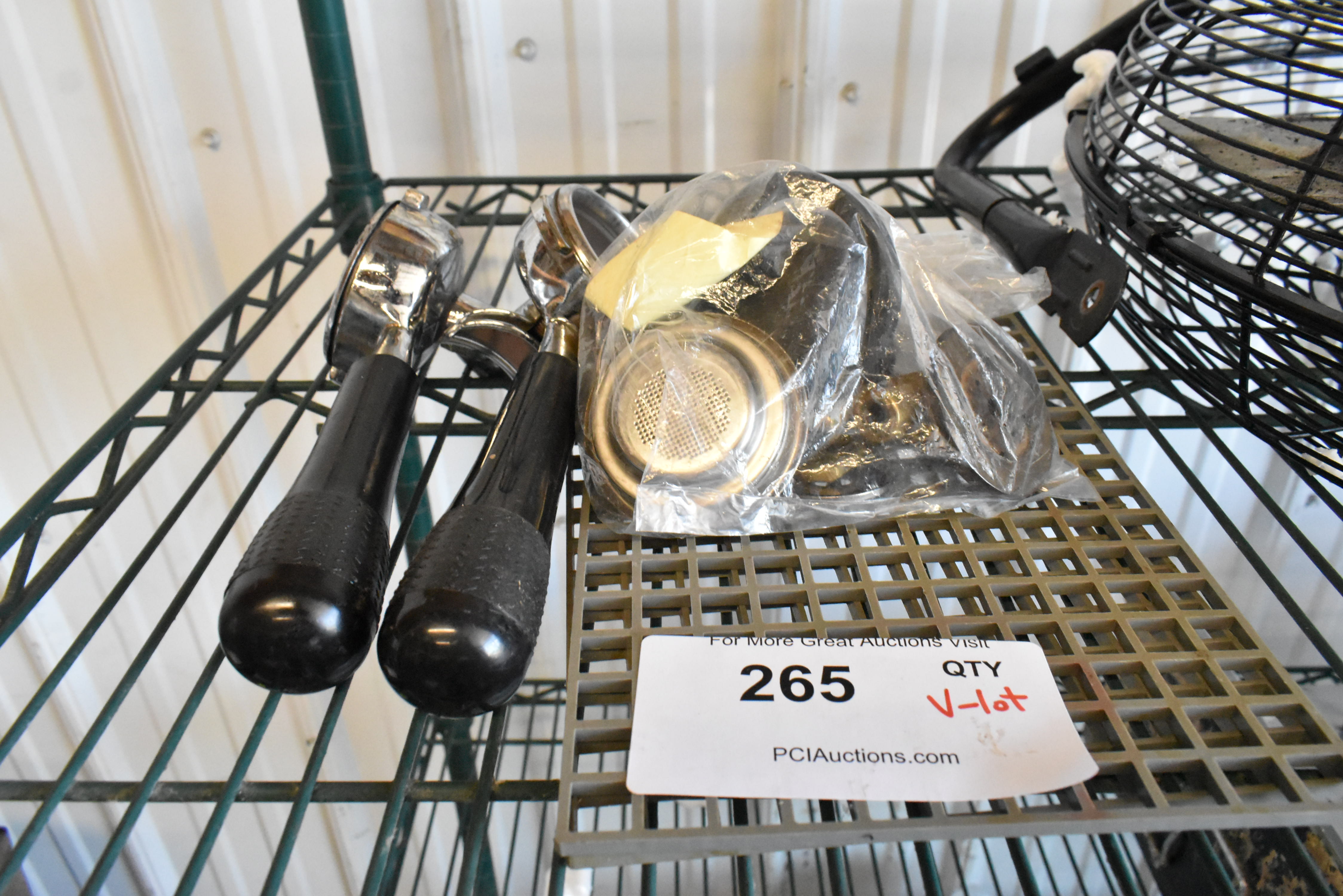
Just portafilters and parts—this lot sold for under $20, but replacements can cost $250+ each for OEM
Replacement Cost Reality
Generic replacements: $50 per portafilter for universal-fit options. These work functionally but may not seal perfectly or match the aesthetic of premium machines.
OEM (Original Equipment Manufacturer) replacements: $250+ per portafilter for brand-specific parts, especially from Italian manufacturers. La Marzocco portafilters can run $300+ because they're precision-manufactured to exact tolerances.
Complete portafilter sets: A 2-group machine typically comes with 2-4 portafilters (often one single-shot and one double-shot per group). Missing all portafilters on a 2-group machine could mean $100 generic replacement or $500+ OEM replacement.
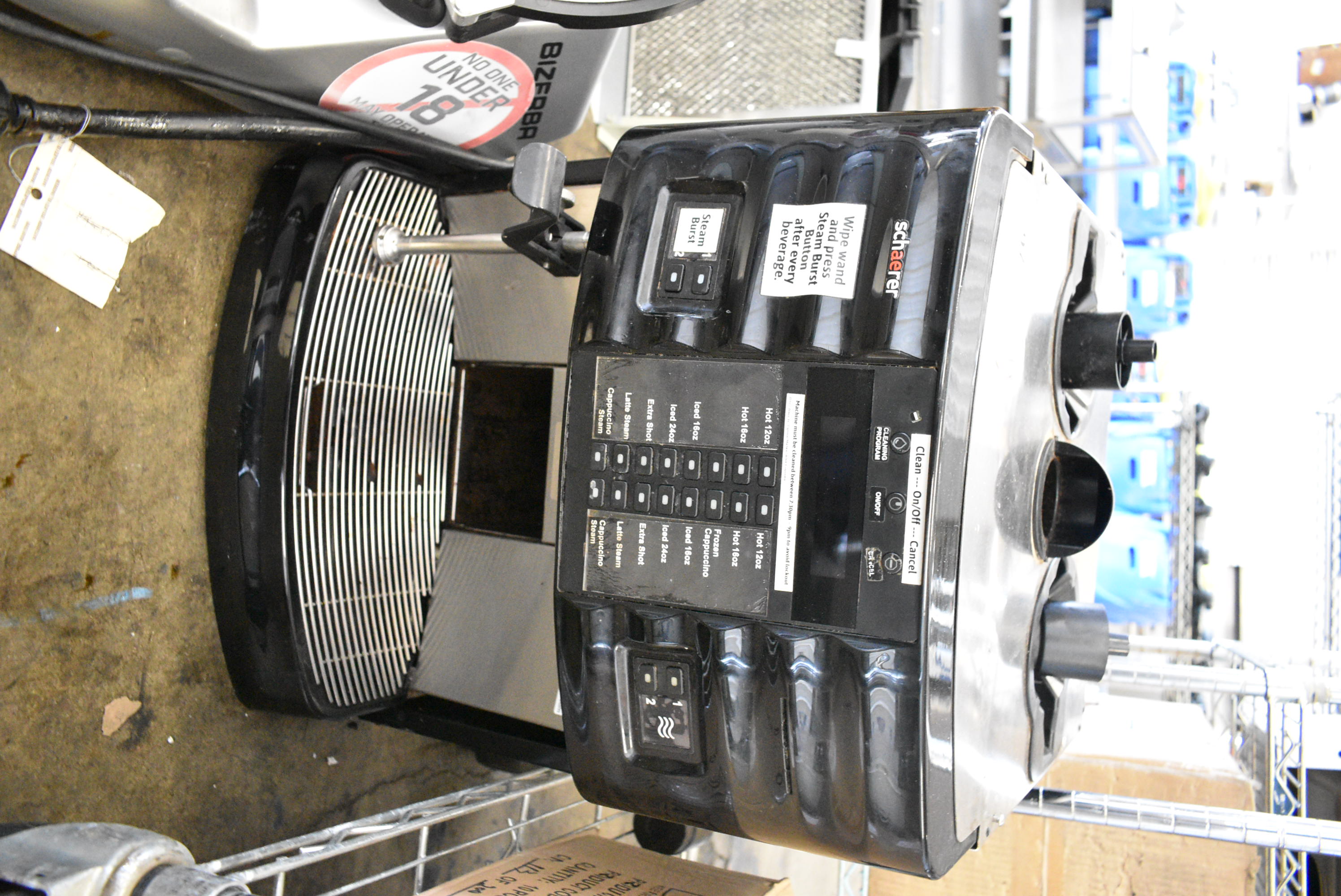
Missing portafilters significantly reduce auction value—factor replacement cost before bidding
Basket Replacement
Baskets (the actual filter screens that sit inside portafilters) wear out faster than the handles. Precision baskets for specialty coffee run $15-$30 each, and you'll need multiple per group head (single, double, and sometimes triple baskets for different drink sizes).
Auction Insider Tip: Machines sold complete with all portafilters and baskets command premiums at auction. When inspecting, count the portafilters and verify they match the group count (minimum 1 per group, ideally 2). Set up an auction alert specifically for portafilters and baskets—when they sell separately, you can often score amazing deals (under $20 for parts worth $100-$500).
Gasket Replacement: Maintenance vs Catastrophe
Portafilter gaskets (easy): The rubber seals at each group head wear out from heat and pressure. Replacement is straightforward—$5-$15 per gasket, user-replaceable in 10 minutes with basic tools.
Internal boiler gaskets (not easy): If internal boiler gaskets fail, you're looking at professional service. These aren't user-serviceable on most commercial machines due to complexity and safety concerns with pressurized hot water systems.
Complete vs Incomplete Units: A $1,000 machine missing $400 in portafilters should sell for $600, right? Wrong. It sells for $300 because buyers mentally add full replacement cost plus hassle factor. Complete machines are worth 2-3x more than incomplete ones at auction.
The Pump Gamble: Why You Can't Test Before You Buy
Here's the uncomfortable truth about espresso machine auctions: you cannot test pump function before you buy.
Pumps require full power, water connection, startup procedure, and time to pressurize. Auction inspections simply don't allow for this level of testing. You can verify power connections, check for obvious damage, inspect cosmetic condition, and look at spec plates—but pump function remains unknown until after the sale.
The Risk Assessment
Commercial espresso machine pumps are robust. These machines are heavily built for continuous commercial use. Pump failure is relatively rare compared to heating element failure or scale-related issues. Most machines at auction have working pumps.
The real risk isn't pump mechanics—it's heating elements, boiler damage, or electronic control failures. If the machine powers on and shows no obvious trauma, odds are good it's functional.
Post-Purchase Testing
After you win a machine, here's how to test it properly:
1. Connect to 208/240V power and water line
2. Follow startup procedure (typically fill boiler, power on, wait 15-20 minutes for temperature)
3. Attach portafilter and pull a shot
4. Listen for pump noise (should be steady, not grinding or rattling)
5. Check water flow and pressure (should deliver smooth extraction, not sputtering or weak flow)
Pump Replacement Economics: If you do discover a failed pump post-purchase, replacement cost varies wildly by brand. Budget machines might have $100 pumps available. Italian premium machines could require $500+ for OEM pumps plus professional installation. For this reason, budget-tier machines with questionable pumps often aren't worth repairing—they become parts units.
Auction Insider Tip: Cheap units (under $200) often sell low not because of confirmed pump problems, but because of uncertainty. If you're mechanically inclined or have a technician relationship, buying 2-3 cheap machines and cannibalize parts can be more economical than buying one premium unit. One will likely work, and you'll have spare parts for the other two.
Maintenance Cadence: The Reality of Owning Commercial Espresso Equipment
Espresso machines require more regular maintenance than most commercial equipment. If you're not prepared for this reality, you'll destroy a good machine through neglect.
Daily Maintenance
Backflushing: Most mid-to-premium commercial machines can be backflushed (requires a release valve to drain the lines). This involves using a blind portafilter basket and running water through the group head to clean coffee oils and residue from internal components.
Frequency: 1-2 times per week with plain water, 1 time per month with espresso machine cleaning chemical. Internet forums will tell you to backflush daily—manufacturers typically recommend weekly for normal volume operations. Don't over-maintain; excessive chemical backflushing can damage gaskets.
Group head cleaning: Wipe group heads after each shift, remove and soak portafilter baskets nightly.
Steam wand purging: Purge steam wands after every milk steaming session (literally every use). Milk residue becomes concrete overnight.
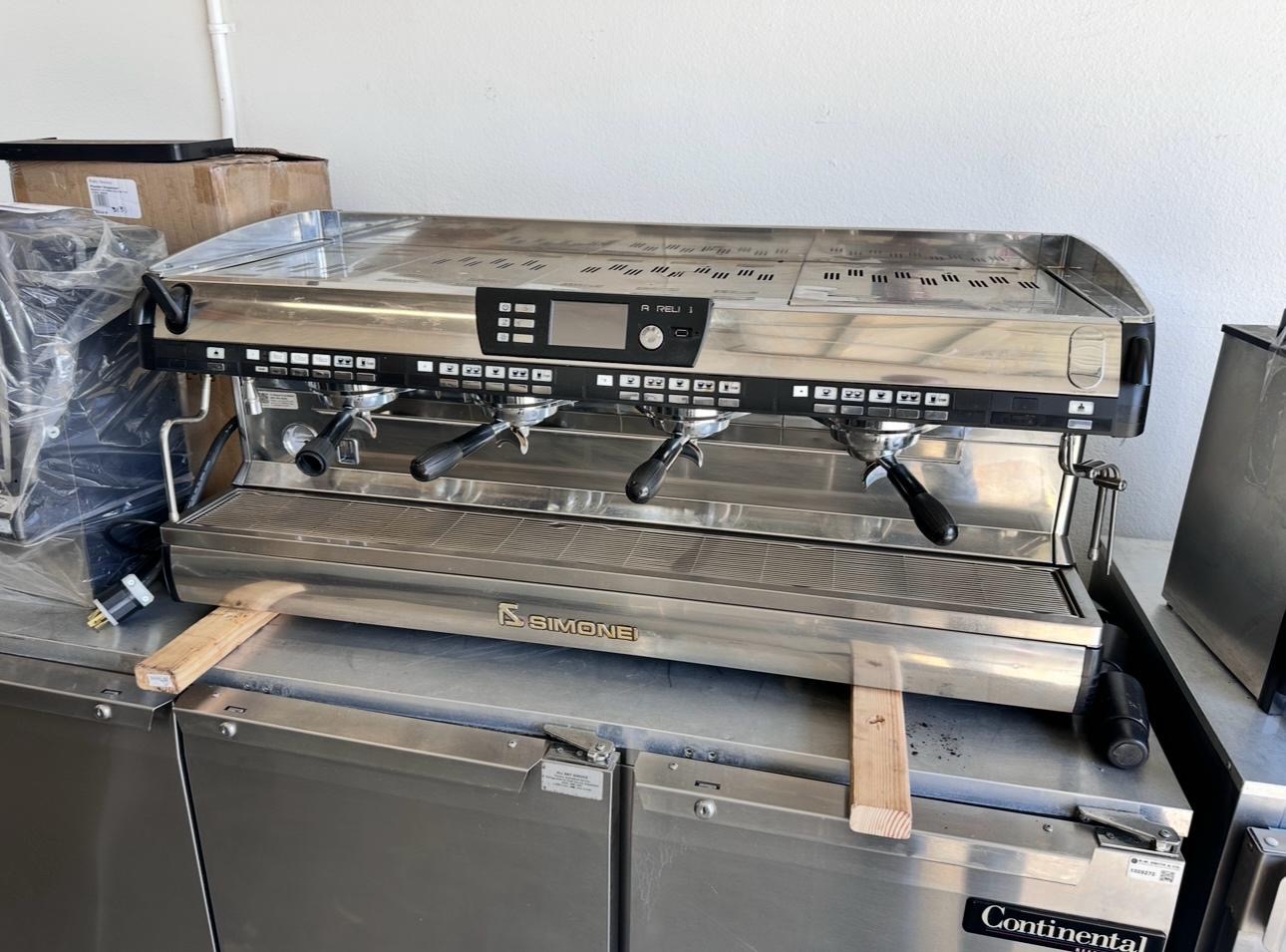
Digital controls simplify maintenance tracking and temperature management
Weekly/Monthly Maintenance
Descaling: Monthly if using soft water, more frequently with hard water (see the scale section above for details).
Gasket inspection: Check portafilter gaskets monthly for wear, cracking, or loss of elasticity. Replace immediately if compromised ($5-$15 per gasket, 10-minute job).
Water filter replacement: If using point-of-use filtration, replace cartridges every 6 months or per manufacturer specs.
Seasonal/Annual Maintenance
Professional service: Annual professional servicing recommended for premium machines. Technician will inspect boiler, test pump pressure, verify temperature accuracy, check internal gaskets, and catch problems before catastrophic failure. Budget $200-$400 depending on location and brand.
The Maintenance Trade-Off: Higher-quality machines require MORE maintenance, not less. That La Marzocco needs backflushing, descaling, gasket replacement, and professional service just like any other machine. The difference is build quality means those maintenance procedures keep it running for 15+ years. Budget machines might require less maintenance simply because they're not worth maintaining—you replace them in 3-5 years instead.
Auction Insider Tip: Machines sold from cafes that clearly maintained their equipment (clean exterior, no scale buildup, complete portafilters, minimal wear) typically have better internal condition. Machines from liquidations where the business failed due to neglect? Buyer beware. Cosmetic condition often predicts internal maintenance history.
Menu Integration Strategy: When Espresso Actually Pays Off
Not every food service operation needs an espresso machine. Here's how to think strategically about whether espresso fits your concept.
The Perfect Espresso Integration: Cafes & Bakeries
Independent coffee shops, bakeries with seating, breakfast-focused concepts without soda fountain contracts—these are slam-dunk espresso opportunities. Why?
No beverage competition: Without Coke/Pepsi contracts dominating the menu, coffee becomes your primary beverage revenue driver.
Complementary food offerings: Muffins, cookies, pastries, breakfast sandwiches—all pair naturally with specialty coffee drinks.
Occasions not transactions: Customers come for the coffee experience, not just caffeine. They'll spend 20 minutes enjoying a latte and pastry, increasing average ticket size.
Full beverage ecosystem: Once you have espresso capability, you can offer Americanos, flat whites, macchiatos, mochas, cappuccinos, lattes in multiple sizes, plus iced variations. That's a dozen menu items from one equipment investment.
The Strategic Integration: Diners & Restaurants
Traditional diners and full-service restaurants face a different calculation. You're competing with reflexive "Coke" or "Pepsi" ordering behavior. But there's opportunity:
Breakfast advantage: Morning customers frequently choose coffee. The ability to upsell from $1.59 regular coffee to $4.25 cappuccino or $5.45 specialty drink is pure margin.
After-dinner dessert pairing: Fine dining especially benefits from post-meal espresso service. A $3.27 espresso or $4.25 cappuccino with a $12 dessert significantly boosts check averages.
Equipment placement matters: Shiny front-of-house espresso machines signal quality. Back-of-house superautomatics prioritize efficiency over perception.
The Poor Integration: Fast Casual & Pizza Shops
Fast casual chains (Applebee's, Chili's style), pizza parlors, sandwich shops with heavy to-go/delivery business—these struggle to justify espresso investment:
Dine-in vs carry-out mismatch: Espresso drinks are sit-down beverages. If 60%+ of your business is delivery or carry-out, demand simply isn't there.
Soda fountain dominance: National chain beverage contracts and fountain soda margins often outperform what you'd gain from espresso.
Family dining patterns: Kids want soda, adults want beer or soda—specialty coffee isn't part of the casual dining occasion for most customers.
If these operations want any coffee capability, they're better served by superautomatics or even pod systems where quality expectations are lower and convenience is valued.
The Integration Test: Ask yourself: Do my target customers come to sit down and enjoy beverages? Do I have complementary food offerings that pair with coffee drinks? Can I train staff to make quality espresso drinks consistently? If you answer yes to all three, espresso integration makes sense.
ROI Math: Why $450 Machines Can Generate $6,000 Monthly
Let's do the math on actual profitability because the numbers are compelling.
Cost Per Drink Breakdown
Specialty drink cost structure (12oz caramel macchiato):
• Coffee beans: $0.25 (using premium beans at $10/lb)
• Milk/syrups/toppings: $0.16
• Paper cup with lid: $0.33
• Labor (60 seconds at $18/hour): $0.30
• Utilities/water: $0.11
Total cost per drink: ~$1.15
Retail price: $5.45
Gross margin per drink: $4.30 (374% markup)
Volume Scenarios
| Operation Type | Drinks Per Day | Daily Margin | Monthly Revenue | Equipment ROI |
|---|---|---|---|---|
| Small Cafe | 30 specialty drinks | $129 | $3,870 | 1-2 months |
| Busy Bakery | 50 specialty drinks | $215 | $6,450 | Under 1 month |
| Restaurant Bar | 20 after-dinner | $86 | $2,580 | 2-3 months |
| Hotel Lobby | 80 guests daily | $344 | $10,320 | 2-3 weeks |
The Equipment Investment Comparison
Regular batch coffee revenue: $1.59 per cup with $0.30 cost = $1.29 margin per cup
Specialty espresso drink revenue: $5.45 per drink with $1.15 cost = $4.30 margin per drink
Revenue differential: $3.01 more margin per customer who chooses specialty over regular coffee
If you convert just 30 customers per day from regular coffee to specialty drinks, that's $90 additional daily margin or $2,700 monthly. A $1,500 espresso machine investment pays for itself in 17 days.
The Upsell Reality: You don't need to eliminate regular coffee service. You need to give customers the OPTION to upgrade. Even a 30% conversion rate from drip to espresso dramatically increases per-customer revenue without changing volume.
Complete Coffee Program Auction Cost
Budget for a complete professional setup purchased at auction:
Espresso machine (2-group mid-tier): $1,500-$2,500
Commercial grinder: $500-$1,500 (separate guide coming soon)
Knock box, portafilter accessories, cleaning supplies: $200-$300
Installation (electrical, plumbing, water filtration): $1,000-$2,000
Total upfront investment: $3,200-$6,300
At 30 specialty drinks per day, your complete program ROI is 1-2 months. At 50 drinks per day, you've paid for everything in 3-4 weeks.
Auction Insider Tip: Complete coffee programs (machine + grinder + accessories) occasionally appear as package deals from cafe liquidations, but typically sell as individual lots. If you're equipping from scratch, budget for multiple auction wins and factor in the time to acquire all components—may take 2-4 auction cycles to assemble everything.
Auction Inspection Checklist: What to Verify Before You Bid
Visual Inspection
- Count portafilters: Minimum 1 per group head, ideally 2. Missing portafilters = $50-$250+ replacement cost each
- Check group head gaskets: Look for cracking, deformation, or obvious wear. Replaceable but indicates maintenance history
- Inspect drip tray for scale: White mineral deposits indicate hard water use and potential internal scaling
- Verify power cord and plug condition: 208/240V plug should be intact, no exposed wiring or damage
- Examine steam wands: Check for milk residue buildup, corrosion, or damage. Clean wands = well-maintained machine
- Count baskets: You need multiple basket sizes (single, double, sometimes triple) per group
- Check body panels and exterior: Dents and scratches are cosmetic, but significant damage may indicate rough handling or drops
Functional Checks (if power available)
- Power on test: Verify machine powers up, displays illuminate, no error codes shown
- Listen for startup sounds: Should hear pump prime, boiler fill, no grinding or rattling noises
- Check indicator lights: Ready indicators, temperature lights, group head indicators all function
- Test switches and buttons: All group head switches, steam wand controls respond to input
Documentation Check
- Locate spec plate: Verify voltage requirements, model number, serial number visible
- Identify brand and model: Research replacement parts availability before bidding
- Check boiler size if listed: Larger boilers = better recovery time for high volume
- Note any included accessories: Blind baskets, cleaning brushes, spare gaskets add value
Red Flags to Avoid
- Heavy scale buildup everywhere: Indicates severe neglect and likely internal damage
- Visible leaks or water damage: Could indicate failed gaskets or cracked boiler
- Missing multiple portafilters: Replacement cost may exceed equipment savings
- Unknown brand with zero online presence: Parts availability nightmare waiting to happen
- Physical damage to group heads: Bent flanges, damaged threads, cracked housings are expensive repairs
- Obvious modifications or non-standard parts: Previous owner jerry-rigging = unknown failure points

Spec plate with model and capacity information—critical for parts research
The Incomplete Machine Trap: A $2,000 machine missing $500 in portafilters should theoretically sell for $1,500, but auction psychology doesn't work that way. Incomplete machines sell for 30-40% of what complete machines fetch because buyers factor in hassle, uncertainty about other missing parts, and potential for hidden issues. Only bid on incomplete machines if you're prepared to invest in completion.
Parts Availability & Service Network Reality
Italian premium machines deliver superior build quality, but parts logistics can be challenging compared to domestic alternatives.
The Parts Availability Hierarchy
Best availability: Major brands with US distribution networks (La Marzocco, Nuova Simonelli, Rancilio). Parts are 1-3 day shipping from US warehouses, service techs are trained on these brands, online communities provide troubleshooting support.
Moderate availability: Established Italian brands without extensive US networks (La Spaziale, Astoria, others). Parts exist but may require 1-2 week international shipping. Service techs may not be brand-certified but can work on them.
Poor availability: Obscure imports, discontinued brands, rebranded equipment. You're searching eBay for used parts, hoping universal components fit, or waiting 4+ weeks for overseas orders with no guarantee of compatibility.
The Downtime Calculation
If your espresso machine is your primary revenue driver (cafe, specialty coffee shop), downtime = lost revenue. Calculate what equipment failure costs you:
• 50 specialty drinks per day at $4.30 margin = $215 daily loss
• 3 days waiting for parts = $645 in lost margin
• Week-long repair = $1,505 in lost revenue
Suddenly that "cheaper" machine with questionable parts availability looks expensive when you factor in business interruption.
Service Network Considerations
Major metro areas have espresso machine service techs trained on Italian equipment. Rural areas may not. Before buying a premium Italian machine, verify:
• Is there a certified service tech within reasonable distance?
• What's their service call fee and typical turnaround time?
• Do they stock common parts or order as needed?
• Can they provide emergency service or are you scheduling weeks out?
Auction Insider Tip: La Marzocco has the best US service network of any Italian brand. If you're in a smaller market where espresso machine techs are scarce, the La Marzocco premium may be worth it purely for service availability. Their parts ship fast, techs know the machines, and online documentation is extensive.
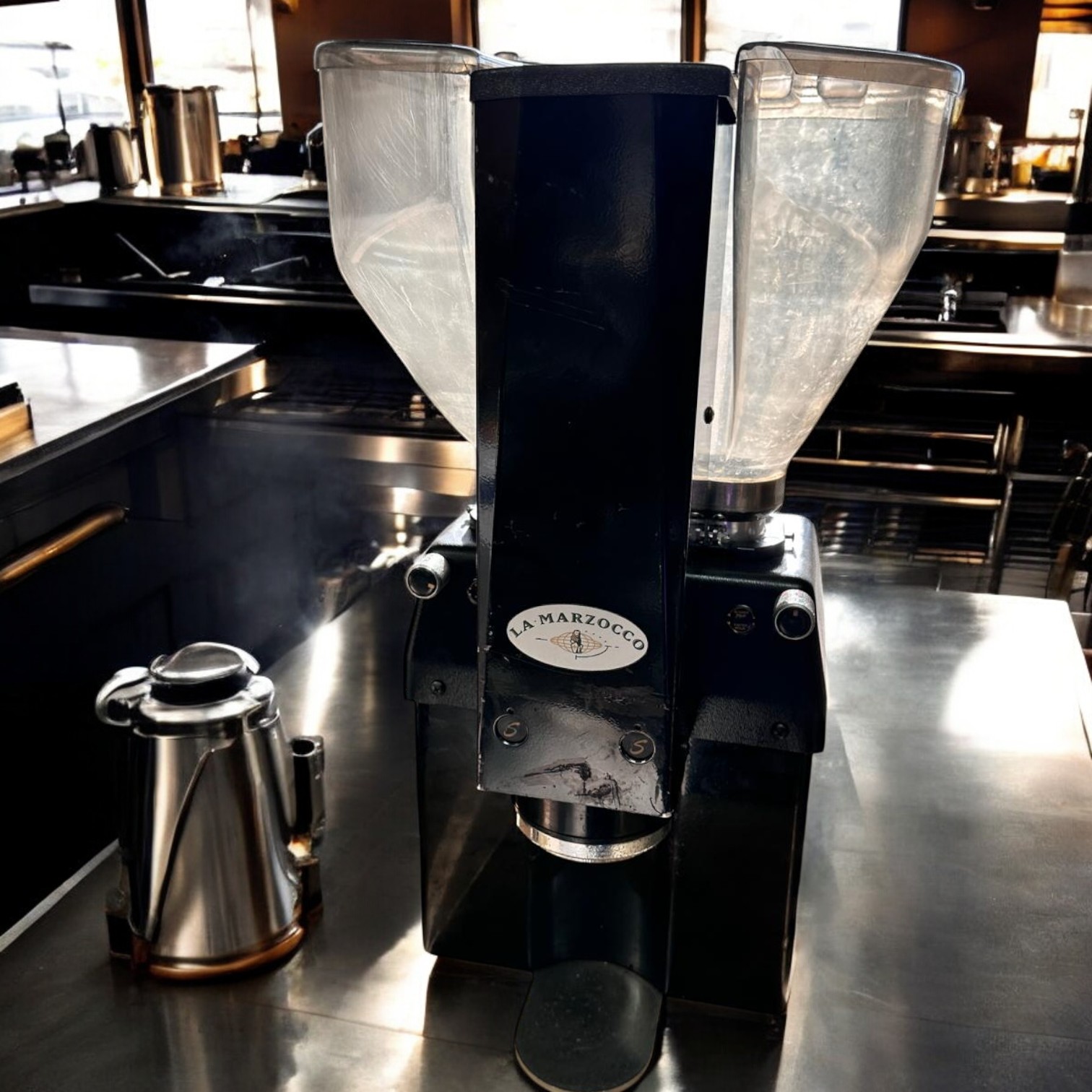
La Marzocco grinder from same ecosystem—parts and service consistency across equipment
Auction Insider Tips: How to Win Without Overpaying
Recognize BNSD Opportunities: Brand new scratch & dent units from premium manufacturers appear regularly at PCI Auctions. These are full-quality machines with cosmetic imperfections—minor dents, wrong color orders, display models. They can sell for 40-60% of retail. If you can live with a small dent, you're getting new-machine performance at used-machine pricing.
The La Marzocco Recognition Gap: That $6,300 dusty La Marzocco sale? One bidder recognized what others didn't. Study high-end brands before auction. When you can identify a $16,000 machine under the grime, you'll win deals that casual buyers pass on.
Set Auction Alerts for Components: Portafilters, baskets, and accessories often sell separately for pennies on the dollar. Set up notifications for these items. A $20 portafilter lot can complete an otherwise-incomplete machine you already own or plan to buy.
Cafe Liquidations = Better Maintenance History: Machines from specialty coffee shops tend to have better maintenance history than machines from restaurants where coffee was secondary. Look at the auction source—a liquidating cafe likely maintained their espresso machine religiously. A failed sports bar probably didn't.
Buy Multiple Budget Machines for Parts Insurance: If you're mechanically inclined, buying 2-3 cheap machines (under $200 each) can be smarter than buying one mid-tier unit. At least one will work, and you'll have spare parts for the others. This strategy works especially well for brands with poor parts availability.
Voltage Verification is Free Insurance: Always check the spec plate during inspection. Verify 208/240V requirements match your facility. This eliminates surprises and ensures you're not bidding on equipment you can't power.
Timing Matters for Competition: Premium Italian machines attract bidding wars when recognized. Budget-tier machines slip through with minimal competition. If you're flexible on brand and prioritize function over prestige, you'll save thousands by targeting the 52% of machines that sell under $500.
The Grinder Integration Question: We're preparing a complete commercial grinder guide, but here's the preview: budget $500-$1,500 at auction for a quality grinder to pair with your espresso machine. Grinder quality matters as much as machine quality for specialty coffee—don't cheap out on the grinder and spend big on the machine.
The Bottom Line: Making the Smart Espresso Investment
After analyzing 173 espresso machine sales and breaking down the economics, brand hierarchies, maintenance realities, and integration strategies, here's what actually matters:
For Specialty Cafes & Artisan Bakeries
Invest in quality. A 2-group Italian mid-tier machine ($1,500-$2,500 at auction) or premium La Marzocco ($3,000-$6,000) makes sense because espresso is your brand identity. Your customers see the machine, judge your quality by it, and return for the craft. Semi-automatic gives you control over quality, and the equipment signals you're serious about coffee.
Auction budget: $2,500-$4,000 for machine + grinder + accessories
ROI timeline: 1-2 months at 30-50 drinks per day
For Restaurants & Diners
Balance visibility with practicality. Front-of-house placement? Get something that looks professional (mid-tier Italian, 1-2 groups, $800-$1,500). Back-of-house convenience? Superautomatic efficiency works fine ($450-$1,000). You're adding espresso as a menu enhancement, not building your brand around it.
Auction budget: $1,200-$2,200 for machine + grinder
ROI timeline: 2-3 months with breakfast/dessert upsells
For High-Volume Operations
Prioritize throughput and reliability. A 3-group workhorse ($1,500-$4,000) or superautomatic for hotel/corporate settings ($800-$1,500) makes sense. Parts availability and service network matter more than brand prestige when you're serving 80+ drinks daily and downtime = lost revenue.
Auction budget: $2,000-$5,000 for machine + commercial-grade grinder
ROI timeline: 2-4 weeks at high volume
What You're Actually Buying
An espresso machine isn't just equipment—it's a menu expansion, a margin improvement, and in many cases, a marketing statement. The difference between a $450 functional machine and a $4,500 La Marzocco isn't always taste (most customers can't tell the difference in a blind test). It's durability, service life, parts availability, and customer perception.
Choose based on your business model, not just auction pricing. The cheapest machine isn't the best deal if it doesn't fit your concept. The most expensive machine isn't worth it if you're not leveraging its prestige.
The Auction Advantage: Even premium La Marzocco machines sell for 30-50% of retail at auction. Mid-tier workhorses can be found for 40-60% off retail. Budget-functional machines sell for pennies on the dollar. The savings are real—but only if you buy the right equipment for your operation and maintain it properly.
Ready to Find Your Espresso Machine?
PCI Auctions handles 600-900 commercial equipment lots weekly, including espresso machines from cafe liquidations, restaurant closures, and brand new scratch & dent inventory.
Every auction starts at $0.01. Every item is photographed. Inspection available before bidding.
Questions about a specific machine? Our equipment experts can help you evaluate condition, verify specs, and determine fair market value before you bid.
Frequently Asked Questions
Can I test an espresso machine before buying at auction?
You can visually inspect machines during preview periods and verify power connections, but full operational testing (pump function, extraction quality, heating) isn't possible without complete power, water, and startup procedures. Most commercial espresso machines are robust, but pump function remains unknown until post-purchase testing.
What's the difference between 1-group, 2-group, and 3-group machines?
Group count indicates how many simultaneous espresso shots you can pull. 1-group machines are suitable for light coffee service (20-30 cups/hour), 2-group handles standard cafe volume (40-60 cups/hour), and 3-group supports high-volume operations (60-90 cups/hour). More groups = higher auction prices, typically ranging from under $1,200 (1-group) to $1,000-$12,000 (3-group) depending on brand.
Are Italian espresso machine brands worth the premium at auction?
Italian brands like La Marzocco command 2-4x the price of mid-tier alternatives, selling for $3,000-$12,000 vs $500-$2,000 for comparable group counts. The premium buys superior build quality (15+ year lifespan vs 5-7 years), better parts availability, and customer perception value for front-of-house installations. For back-of-house use or operations where customers don't see the equipment, mid-tier workhorses deliver similar functional performance at significant savings.
What voltage do commercial espresso machines require?
Nearly all commercial espresso machines require 208/240V single-phase power. 115V units are uncommon and typically underpowered for commercial use. 3-phase power is essentially unheard of in espresso equipment. If you're opening a coffee-focused establishment, 240V service should be part of your initial buildout, not an afterthought.
How much does it cost to replace missing portafilters?
Generic replacement portafilters cost approximately $50 each. OEM (original equipment manufacturer) replacements, especially from Italian brands, can cost $250+ per portafilter. A 2-group machine missing all portafilters could require $100-$500+ in replacements. Machines sold complete with portafilters and baskets command significant premiums at auction—often 2-3x more than incomplete units.
How do I prevent scale buildup in my espresso machine?
Install water softening or filtration before the machine. Whole-facility water softeners benefit all equipment. Point-of-use filters ($150-$400) are the minimum for espresso machines. Without soft water, monthly descaling is required in hard water areas, and even then, scale will eventually damage the boiler. Prevention through water treatment is vastly more economical than dealing with scale damage.
What's the difference between semi-automatic and superautomatic machines?
Semi-automatic machines require manual operation—grinding, dosing, tamping, and extraction timing controlled by the barista. These deliver craft coffee but require skilled operators. Superautomatic machines are push-button: integrated grinders, automatic tamping, programmable recipes, minimal training. Semi-autos from premium brands sell for $500-$12,000 at auction. Superautomatics typically sell for $450-$1,500 because specialty cafes prefer manual control.
How long does an espresso machine last?
Premium Italian machines with proper maintenance can last 15+ years in commercial use. Mid-tier brands (Nuova Simonelli, Rancilio) typically deliver 7-10 years. Budget or unknown brands may last 3-5 years. Lifespan depends heavily on water quality (soft water is critical), maintenance adherence (backflushing, descaling), and usage volume. A well-maintained machine can outlast its initial owner's business.
Do I need a commercial grinder with my espresso machine?
Yes. Espresso quality depends equally on grinder quality and machine quality. Budget $500-$1,500 at auction for a commercial grinder (guide coming soon). Some superautomatic machines have integrated grinders, but specialty cafes prefer separate grinders for precise control and the ability to switch between different beans without machine downtime.
What maintenance does an espresso machine require?
Daily: purge steam wands, wipe group heads. Weekly: backflush with water (1-2x), group head deep cleaning. Monthly: backflush with chemical cleaner, gasket inspection, descaling if using hard water. Every 6 months: replace water filter cartridges. Annually: professional service recommended for premium machines ($200-$400). Higher-quality machines require MORE maintenance but reward it with longer service life.
Can I use an espresso machine without a water line connection?
Small machines with internal reservoirs exist for manual filling, but this is impractical for commercial volume. Any serious coffee service operation should have direct plumb connection to water supply with autofill capability. Budget $200-$500 for plumbing connection during installation. Manual fill is only viable for food trucks or very light service (under 10 drinks daily).
How much revenue can an espresso machine generate?
Specialty drinks cost approximately $1.15 to produce (beans, milk, cup, labor) and sell for $4.25-$5.45, generating $3.01-$4.30 margin per drink. At 30 specialty drinks daily, that's $90-$129 daily margin or $2,700-$3,870 monthly. At 50 drinks daily, you're looking at $6,450 monthly in margin. A $1,500 machine investment pays for itself in 2-4 weeks at moderate volume.
Are brand new scratch & dent machines a good deal?
BNSD (brand new scratch & dent) machines offer full functionality with cosmetic imperfections. These can sell for 40-60% of retail at auction—essentially new-machine performance at used-machine pricing. If a small dent doesn't bother you (or won't be visible in your installation), BNSD units represent excellent value, especially from premium Italian brands.
